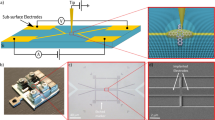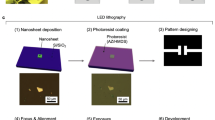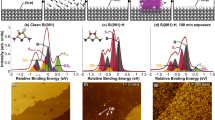Abstract
Quantum electronic components1,2—such as quantum antidots and one-dimensional channels—are usually defined from doped GaAs/AlGaAs heterostructures using electron-beam lithography or local oxidation by conductive atomic force microscopy3,4. In both cases, lithography and measurement are performed in very different environments, so fabrication and test cycles can take several weeks. Here we describe a different lithographic technique, which we call erasable electrostatic lithography (EEL), where patterns of charge are drawn on the device surface with a negatively biased scanning probe in the same low-temperature high-vacuum environment used for measurement. The charge patterns locally deplete electrons from a subsurface two-dimensional electron system (2DES) to define working quantum components. Charge patterns are erased locally with the scanning probe biased positive or globally by illuminating the device with red light. We demonstrate and investigate EEL by drawing and erasing quantum antidots, then develop the technique to draw and tune high-quality one-dimensional channels5,6. The quantum components are imaged using scanned gate microscopy7,8,9,10,11. A technique similar to EEL has been reported previously, where tip-induced charging of the surface or donor layer was used to locally perturb a 2DES before charge accumulation imaging12.
This is a preview of subscription content, access via your institution
Access options
Subscribe to this journal
Receive 51 print issues and online access
$199.00 per year
only $3.90 per issue
Buy this article
- Purchase on Springer Link
- Instant access to full article PDF
Prices may be subject to local taxes which are calculated during checkout




Similar content being viewed by others
References
Beenakker, C. W. J. & van Houten, H. in Solid State Physics Vol. 44 (eds Ehrenreich, H. & Turnbull, D.) 1–228 (Academic, New York, 1991)
Smith, C. G. Low-dimensional quantum devices. Rep. Prog. Phys. 59, 235–282 (1996)
Held, R., Heinzel, T., Studerus, P., Ensslin, K. & Holland, M. Semiconductor quantum point contact fabricated by lithography with an atomic force microscope. Appl. Phys. Lett. 71, 2689–2691 (1997)
Curson, N. J. et al. Ballistic transport in a GaAs/AlxGa1-xAs one-dimensional channel fabricated using an atomic force microscope. Appl. Phys. Lett. 78, 3466–3468 (2001)
vanWees, B. J. et al. Quantised conductance of point contacts in a two dimensional electron gas. Phys. Rev. Lett. 60, 848–850 (1988)
Wharam, D. A. et al. One-dimensional transport and the quantisation of ballistic resistance. J. Phys. C 21, L209–L214 (1988)
Eriksson, M. A. et al. Cryogenic scanning probe characterization of semiconductor nanostructures. Appl. Phys. Lett. 69, 671–673 (1996)
Woodside, M. T. & McEuen, P. L. Scanned probe imaging of single-electron charge states in nanotube quantum dots. Science 296, 1098–1101 (2002)
Crook, R. et al. Quantum-dot electron occupancy controlled by a charged scanning probe. Phys. Rev. B 66, 121301 (2002)
Ihn, T. et al. Scanning gate measurements on a quantum wire. Physica E 12, 691–694 (2002)
Topinka, M. A. et al. Coherent branched flow in a two-dimensional electron gas. Nature 410, 183–186 (2001)
Tessmer, S. H., Glicofridis, P. I., Ashoori, R. C., Levitov, L. S. & Melloch, M. R. Subsurface charge accumulation imaging of a quantum Hall liquid. Nature 392, 51–54 (1998)
Tortonese, M., Barret, R. C. & Quate, C. F. Atomic resolution with an atomic force microscope using piezoresistive detection. Appl. Phys. Lett. 62, 834–836 (1993)
Crook, R., Smith, C. G., Simmons, M. Y. & Ritchie, D. A. Imaging electrostatic microconstrictions in long 1D wires. Physica E 12, 695–698 (2002)
Starikov, A. A. et al. Effects of accidental microconstriction on the quantized conductance in long wires. Preprint at 〈arxiv.org/abs/cond-mat/0206013〉 (2002).
Crook, R., Smith, C. G., Simmons, M. Y. & Ritchie, D. A. One-dimensional probability density observed using scanned gate microscopy. J. Phys. Condens. Matter 12, L735–L740 (2000)
Williamson, J. G., Timmering, C. E., Harmans, C. J. P. M., Harris, J. J. & Foxon, C. T. Quantum point contact as a local probe of the electrostatic potential contours. Phys. Rev. B 42, R7675–R7678 (1990)
Yacoby, A. et al. Nonuniversal conductance quantization in quantum wires. Phys. Rev. Lett. 77, 4612–4615 (1996)
Thomas, K. J. et al. Interaction effects in a one-dimensional constriction. Phys. Rev. B 58, 4846–4852 (1998)
Buttiker, M. Quantized transmission of a saddle-point constriction. Phys. Rev. B 41, 7906–7909 (1990)
Field, M. et al. Measurements of Coulomb blockade with a noninvasive voltage probe. Phys. Rev. Lett. 70, 1311–1314 (1993)
Johnson, K. L. Contact Mechanics (Cambridge Univ. Press, Cambridge, UK, 1987)
Eriksson, M. A. et al. Effect of a charged scanned probe microscope tip on a subsurface electron gas. Superlattices Microstruct. 20, 435–440 (1996)
Micolich, A. P. et al. Evolution of fractal patterns during a classical-quantum transition. Phys. Rev. Lett. 87, 036802 (2001)
Bennett, C. H. & DiVincenzo, D. P. Quantum information and computation. Nature 404, 247–255 (2000)
Acknowledgements
We thank K. J. Thomas, C. J. B. Ford and M. Kataoka for discussions. A.C.G. fabricated the sample and made the antidot measurements. C.G.S. coordinated the scanning-probe measurement facilities. I.F. and H.E.B. grew the wafer using molecular beam epitaxy (MBE). D.A.R. coordinated the MBE facilities. This work was supported by the EPSRC.
Author information
Authors and Affiliations
Corresponding author
Ethics declarations
Competing interests
The authors declare that they have no competing financial interests.
Rights and permissions
About this article
Cite this article
Crook, R., Graham, A., Smith, C. et al. Erasable electrostatic lithography for quantum components. Nature 424, 751–754 (2003). https://doi.org/10.1038/nature01841
Received:
Accepted:
Issue Date:
DOI: https://doi.org/10.1038/nature01841
This article is cited by
-
Imaging magnetic focusing of coherent electron waves
Nature Physics (2007)
-
Drawing quantum circuitry
Nature (2003)
Comments
By submitting a comment you agree to abide by our Terms and Community Guidelines. If you find something abusive or that does not comply with our terms or guidelines please flag it as inappropriate.



